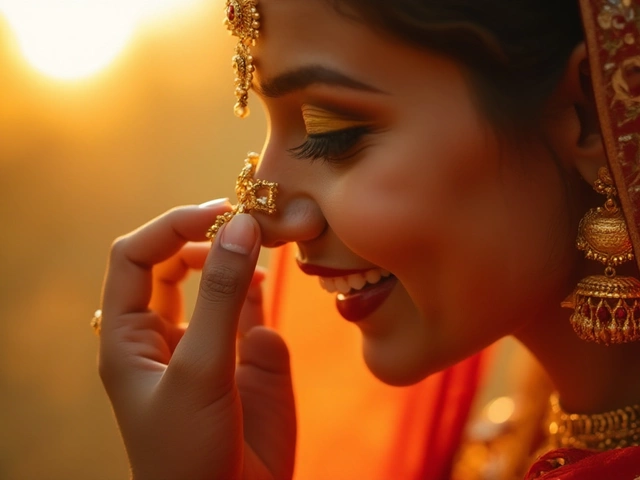
The Sikh Kara bangle, a defining element of Sikh spiritual identity, embodies profound meaning with its simplistic yet powerful design. Rooted in centuries of tradition, the Kara holds a place of honor as one of the Five Ks in Sikhism, serving as a constant reminder of ethical and moral conduct.
Traditionally forged from iron or steel, this circular bangle is an emblem of unity and eternity, reflecting the unbroken nature of life and the divine circle of God. Those who wear it, often on their right wrist, do so to fortify their spiritual journey, ensuring their actions align with righteous principles.
Beyond its spiritual tenor, the intricacies of the Kara's creation reveal the artistry and craftsmanship that have defined this symbol for generations. As we delve into the rich narrative of the Sikh Kara, we explore its historical origins, its deep-rooted symbolism, and its enduring presence in both traditional and modern Sikh life.
- Historical Roots of the Sikh Kara
- Symbolism and Meaning
- The Making of a Kara
- Cultural Significance in Sikh Life
- The Kara in Modern Times
Historical Roots of the Sikh Kara
The history of the Sikh Kara is as rich and profound as the tradition it represents, deeply intertwined with the formation and evolution of Sikhism itself. The origins of the Kara can be traced back to the teachings of Guru Nanak, the first of the Sikh Gurus, who laid the foundation for what would become a faith deeply rooted in principles of humility, equality, and service. However, it was Guru Gobind Singh, the tenth Sikh Guru, who in 1699 formalized the wearing of the Kara as one of the Five Ks, items of faith central to Sikh identity.
Guru Gobind Singh introduced these symbols to unite his followers under a shared spiritual and physical discipline, which would bind this nascent community with a sense of brotherhood that transcended the bounds of the material world. The Kara, being circular, symbolized the eternal nature of God and the interconnectedness of all actions within this divine circle. It served as a constant reminder that the wearer should engage in the world with righteousness and integrity.
Historically, the Sikh Kara was fashioned from iron to denote strength and resilience, essential qualities in the turbulent socio-political landscape of the time. During the era of the Mughal Empire's dominance in India, Sikhs faced significant persecution and challenges to their way of life. The Kara served not just as a piece of religious insignia but as a functional item that symbolically defended this newfound spiritual sovereignty.
"The Kara is the hand’s armor in the battlefield of life," as noted by one of the venerable Sikh scholars, reinforcing its role as a constant protector and guide.
This symbolic bangle continues to carry the legacy of resilience and strength passed down through generations. The significance of the Sikh Kara extends beyond its immediate religious context, reflecting the socio-historical struggles faced by the Sikhs. It also embodies the universal principles of Sikhism - unity, equality, fortitude, and the enduring spirit against adversity. In this way, the history of the Sikh Kara is not merely about religious tradition but a testament to the enduring spirit of Sikh resilience and identity.
Symbolism and Meaning
In the realm of Sikhism, the significance of the Kara, a simple metallic bangle, stretches beyond its circular design, delving deep into the philosophical and spiritual ethos of the faith. The circular shape of the Kara itself is deeply emblematic, representing the infinite nature of God, devoid of beginning or end, an eternal circle of life that encompasses the believer. It's a perpetual reminder of the divine presence in every action and thought, urging the wearer to live consistently with truthful principles and accountability in mind.
The material of the Sikh Kara, traditionally iron or steel, adds another layer of meaning. It symbolizes strength and resilience, epitomizing the unyielding human spirit in the face of adversity. This strength is not just physical but also spiritual, emphasizing the inner fortitude needed to adhere to the high moral standards expected of Sikhs. Each time a Sikh glances at their wrist, it serves as a reminder of the vow to maintain justice and integrity in all interactions. This commitment is not limited to the individual but extends to the community, fostering a collective identity centered around righteousness and honesty.
As part of the

The Making of a Kara
The crafting of the Sikh Kara is an art passed down through generations, each bangle a testament to the skill and devotion of its artisan. Traditionally, these bangles are forged from simple yet resilient materials like iron or steel, chosen for their symbolic strength and purity. The process begins with melting and refining metal to remove impurities, ensuring the Kara embodies both physical and spiritual integrity. Skilled blacksmiths often shape the heated metal by hand, a painstaking process that requires precision and patience, and a deep understanding of the metal's properties.
As the metal takes shape, it is cooled and reheated repeatedly, a cycle reflecting spiritual refinement and the forging of character. The circular design of the Kara is deliberate, symbolizing the eternal, unbroken cycle of life and the universe, reinforcing the connection between the wearer and the divine. Each Kara is unique, its finish smooth, occasional embellishments included, though tradition often favors simplicity, allowing the spiritual meaning to shine through unadorned. Artisans may etch meaningful patterns or phrases into the surface, adding a personal touch to this spiritual emblem.
Modern methods sometimes employ machinery for precision, yet many Sikhs value the handcrafting process for its personal touch and connection to tradition. By maintaining traditional methods, the crafting of a Sikh Kara becomes not just a physical task but a meditative practice, allowing artisans to imbue each bangle with personal dedication and respect for the faith's tenets. Even while adapting to contemporary demands, the essential qualities of the Kara remain unchanged. The crafting process is not merely about creating an ornament but about producing a meaningful symbol, cherished by the Sikh community for its depth and resilience.
The Sikh Kara is more than its circular form; it represents an unyielding commitment to spiritual and ethical discipline. – Harjinder Singh Sabharwal, cultural historian
The intrinsic value of a Kara is not solely in its material but in the story of its creation and the journey it represents. Some Karas are inscribed with words of remembrance or scripture, making each piece a personal keepsake that bears the history and hopes of its wearer. It's a powerful reminder of unwavering faith and moral strength, serving a dual purpose as a piece of spiritual jewelry and a marker of religious identity.
Cultural Significance in Sikh Life
In the rich tapestry of Sikh culture, the Sikh Kara bangle holds a central position, symbolizing various facets of spirituality and identity that are interwoven into everyday life. Wearing the Kara is not just about following a tradition; it is a daily affirmation of faith and a reflection of one's commitment to the high ideals of Sikhism. Its placement on the wrist serves as an omnipresent reminder to engage in conduct that is just, compassionate, and aligned with Sikh ethics. This metal ring transforms from a mere accessory into a moral compass, guiding the actions of those who wear it, whether they are deep in meditation or navigating the challenges of modern life.
The Kara's unbreakable circle is particularly significant because it embodies the eternal and infinite nature of the divine. As part of the panj kakaar, or Five Ks, the Kara joins four other physical symbols that uniformly distinguish and bind Sikhs under a common faith: Kesh (uncut hair), Kangha (a wooden comb), Kachera (cotton undergarments), and Kirpan (a ceremonial sword). Each symbol serves an educational purpose, teaching Sikhs about different tenets of their faith. The Kara, with its perpetual loop, represents the continuity of life and the steadfast presence of God, an idea eloquently expressed by the ancient Sikh scripture, Guru Granth Sahib, “A truly evolved human being is one who realizes that he and the divine are one.”
Daily life for a Sikh is infused with practices and rituals where the Kara plays an influential role. During religious gatherings and ceremonies, the Kara is exposed prominently, serving as a badge of courage and honor in the pursuit of spiritual enlightenment. Its significance is further underscored during Anand Karaj, the Sikh marriage ceremony, where it stands as a symbol of eternity, unity, and purity in the sacred bond. The physical presence of the Kara during such pivotal life moments connects the wearer to their community and heritage, fortifying a shared cultural identity. As Bhai Gurdas, a respected Sikh philosopher, puts it,
“The Kara is not only an ornament, but a teaching which is visible at all times – a reminder of one's continuous connection with the Almighty.”Through all these manifestations, the Kara transcends being a mere object, instead forming an indelible part of the cultural lives it touches.

The Kara in Modern Times
In today's world, the Sikh Kara continues to be a powerful symbol of faith and identity among Sikhs. As the globe has shrunk with the advent of technology and increased connectivity, the Kara has seen its influence spread beyond the traditional lands of Punjab, finding a place of significance across continents. This sacred bangle is worn proudly by Sikh youth, who navigate the complexities of a digital age while staying connected to their roots. It's a testament to the central tenets of Sikhism that remain relevant and resonate with followers in diverse new settings.
As more people become aware of Sikh culture worldwide, the Kara often sparks curiosity and dialogue. This conversation enables a shared understanding between cultures, presenting an opportunity for non-Sikhs to appreciate the spiritual depth of the Sikh community and its values. You can find the traditional bangles of India being highlighted in cultural events, where the Kara, among other symbols, serves as a thread connecting modern adherents to their historical past. The significant interest in multicultural expression has brought about a fusion of traditional designs with modern aesthetics, offering Sikh jewelry a wholly tangible modern-day appeal.
Contemporary jewelers have started to experiment with materials, incorporating metals like silver and gold while respecting the traditional sanctity of the original iron or steel craftsmanship. In the fashion world, the Kara has made its mark as well, with style influencers and designers acknowledging its elemental beauty and its implications in promoting cultural awareness. Despite these trendy interpretations, the central notion of the Kara as a representation of ethical behavior and spiritual mindfulness remains untouched, reflecting its adaptability to modern ideologies.
The Kara's journey into modern society is not without its challenges. In some regions or professions, wearing religious symbols can lead to misunderstandings, which highlights the importance of continued education and awareness.
"The Kara is a circle of unity that transcends generations and boundaries," one Sikh scholar remarked, emphasizing the shared responsibility to honor and preserve its virtues in an evolving world.As much as it remains a personal reminder for the wearer, the Kara also serves as a public symbol of peace, responsibility, and equality, aligning with global calls for more inclusive and diverse societies.
Interestingly, the increasing popularity of the Kara has given rise to data that reveals its significance in various communities. A study presented in a global cultural forum highlighted that over 80% of young Sikhs living outside India still consider the Kara as a vital element of their personal identity. Such statistics underscore the enduring impact of the Sikh bangle meaning in forming both individual and collective identities. Consequently, in a rapidly changing world, the Kara continues to manifest its importance, blending ancient spirituality with modern expression, making its way in contemporary social fabric and ensuring its legacy for future generations.


